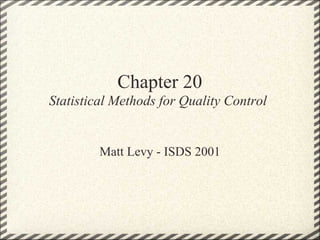
Chapter 20 Lecture Notes
- 1. Chapter 20 Statistical Methods for Quality Control Matt Levy - ISDS 2001
- 2. Total Quality A people focused management system that aims for continual increase in customer satisfaction, at a continually lower real cost. Broad concept implemented differently in every organization. Has three fundamental principles: Focus on Customers and Stakeholders. Participation and Teamwork throughout the organization. Focus on continuous improvement and continuous learning. Three quality management frameworks to talk about: Malcolm Baldridge Nat'l Quality Award ISO 9000 Six Sigma
- 3. Malcolm Baldridge Nat'l Quality Award Introduced by Congress to reward U.S. based companies for quality and performance. Malcolm Baldridge - U.S. Commerce Secretary 1981-1987 Interesting note about your teacher -- dad worked directly under M.B. as an Econometricist for the D.O.C. Award based on seven key areas: leadership strategic planning customer and market focus measurement, analysis, and knowledge management human resource focus process management business results
- 4. ISO 9000 ISO - International Standards Organization Series of 5 international standards The standards describe what is needed maintain effective quality conformance systems. For example: ensuring measurement and testing equipment is calibrated correctly. And for maintaining things like adequate record keeping.
- 5. Six Sigma Another quality assurance methodology Came from motorola (3.4 defects per million opportunities) Any error that is passes on to the customer is considered a defect. An organization may undertake 2 kinds of Six Sigma projects: DMAIC (Define, Measure, Analyze, Improve, and Control) to help redesign existing processes. DFSS (Design for Six Sigma) to design new products, processes, or services.
- 6. Other Important Concepts of Six Sigma Quality Assurance - The entire system of policies, procedures, and guidelines established by the org. to maintain quality. Quality Engineering - To include quality in the design of products and processes and to identify quality problems prior to production. Quality Control - Series of inspections and measurements to determine if quality standards are being met.
- 7. Statistical Process Control This section considers quality control procedures for a production process where goods are manufactured continuously. There can be different causes for quality degradation: Assignable Causes - for example tools wearing out, poor quality of raw materials, or operator error. In this case the process should be corrected or adjusted ASAP. Common Causes - Randomly occurring variations in materials. For example temperature, humdity, etc. This is something that cannot be readily controlled through process refinement.
- 8. Statistical Process Control When assignable causes are detected, we conclude the process is out of control When only common causes are detected, we conclude the process is in control or in statistical control.
- 9. Control Charts Provides a basis for deciding whether variation in output is due to common causes (in control) or assignable causes (out of control) Control Charts are classified by the type of data they contain. Examples are: Sample Mean Chart, R Chart, p Chart and np Chart. Control Charts are pretty simple. They contain an upper control limit (UCL), a Lower Control Limit (LCL), a center line (process mean) and progress in sequentially in time.
- 10. Sample Mean (x-bar) Chart To build the sample mean chart, remember the sampling distribution of x-bar. Specifically that the standard error = σ/√n The sampling distribution of x-bar is used to determine if the process is in control. Also recall from our study on normal probability distributions that 99.7% of the values of a normally distributed random variable are within ± 3 deviations of the mean. This sets our upper and lower control limits: If the process mean and standard deviation are unknown we can get our Process mean from the overall sample mean, and our CL's from the Average Range (see Figures 20.4 - 20.8)
- 11. R Chart Similarly to how we do a chart centered around the mean, we can also do one centered around the range. In this case, the range of a sample can be thought of as a random variable with it's own mean and standard deviation. The average range (R-bar) provides an estimate of the mean. The estimate of the standard deviation of the range can be derived from R-bar and a standard control chart (20.3). See Figures 20.10 - 20.15 to understand how this was derived.
- 12. p Chart Usually used when output quality is measured in defective or non- defective items. p stands for proportion, and we use p-bar, the proportion of defective items found in a sample. The sampling distribution of p-bar is the same as in Ch.7. Please review this as well as Figures 20.16 and the ≥ 5 rule for determining large sample size. Control Limits for a p Chart:
- 13. np Chart Usually when measuring the number of defective items in a sample. n is the sample size. p is the probability of observing a defective item when the process is in control. The same ≥ 5 rule applies as in the p chart. Control Limits for a np chart:
- 14. Interpretation of Control Charts The location and pattern of points on a control chart enable us to determine with a small probability of error whether our process is in statistical control. Any data point outside the control limits is a primary indication our process is out of control -- corrective action should be taken ASAP. Also look for points that are on one side of the center line, and/or gradual shifts or trends over time.
- 15. Summary Make sure you read through Chapter 20 Section 2. Make sure you attempt the homework, we'll work through them on Wednesday.